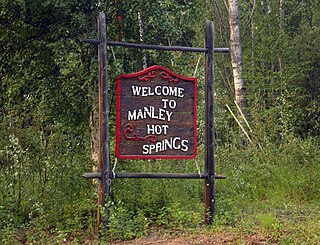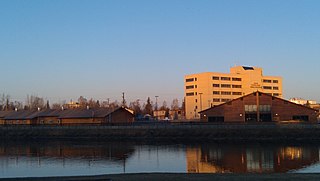Related Research Articles

Fairbanks is a home rule city and the borough seat of the Fairbanks North Star Borough, Alaska, United States. Fairbanks is the largest city in the Interior region of Alaska and the second largest in the state. The 2020 Census put the population of the city proper at 32,515 and the population of the Fairbanks North Star Borough at 95,655, making it the second most populous metropolitan area in Alaska after Anchorage. The Metropolitan Statistical Area encompasses all of the Fairbanks North Star Borough and is the northernmost Metropolitan Statistical Area in the United States, located 196 miles by road south of the Arctic Circle.

North Pole is a small city in the Fairbanks North Star Borough, Alaska, United States. Incorporated in 1953, it is part of the Fairbanks metropolitan statistical area. As of the 2020 census, the city had a population of 2,243, up from 2,117 in 2010. Despite its name, the city is about 1,700 miles south of Earth's geographic North Pole and 125 miles south of the Arctic Circle.

Diomede is an incorporated town and is the only habitable area on Little Diomede Island. The island is located in the Nome Census Area of the Unorganized Borough of the U.S. state of Alaska. All the buildings are on the west coast of Little Diomede, which is the smaller of the two Diomede Islands located in the middle of the Bering Strait between the United States and the Russian Far East. Diomede is the only settlement on Little Diomede Island. The population is 82 people, down from 115 at the 2010 census and 146 in 2000.

Manley Hot Springs is a census-designated place (CDP) in Yukon-Koyukuk Census Area, Alaska, United States. At the 2020 census the population was 169, up from 89 in 2010.

Nenana (Lower Tanana: Toghotili; is a home rule city in the Yukon-Koyukuk Census Area of the Unorganized Borough in the Interior of the U.S. state of Alaska. Nenana developed as a Lower Tanana community at the confluence where the tributary Nenana River enters the Tanana. The population was 378 at the 2010 census, down from 402 in 2000.

Tanana is a city in the Yukon-Koyukuk Census Area in the U.S. state of Alaska. At the 2010 census the population was 246, down from 308 in 2000. It was formerly known as Clachotin, adopted by Canadian French.

The University of Alaska Fairbanks is a public land-, sea-, and space-grant research university in College, Alaska, a suburb of Fairbanks. It is the flagship campus of the University of Alaska system. UAF was established in 1917 and opened for classes in 1922. Originally named the Alaska Agricultural College and School of Mines, it became the University of Alaska in 1935. Fairbanks-based programs became the University of Alaska Fairbanks in 1975.

The Alaska Railroad is a Class II railroad that operates freight and passenger trains in the state of Alaska. The railroad's mainline runs between Seward on the southern coast and Fairbanks, near the center of the state. It passes through Anchorage and Denali National Park, to which 17% of visitors travel by train.

Chicago Public Schools (CPS), officially classified as City of Chicago School District #299 for funding and districting reasons, in Chicago, Illinois, is the fourth-largest school district in the United States, after New York, Los Angeles, and Miami-Dade County. For the 2020–21 school year, CPS reported overseeing 638 schools, including 476 elementary schools and 162 high schools; of which 513 were district-run, 115 were charter schools, 9 were contract schools and 1 was a SAFE school. The district serves 340,658 students. Chicago Public School students attend a particular school based on their area of residence, except for charter, magnet, and selective enrollment schools.

District heating is a system for distributing heat generated in a centralized location through a system of insulated pipes for residential and commercial heating requirements such as space heating and water heating. The heat is often obtained from a cogeneration plant burning fossil fuels or biomass, but heat-only boiler stations, geothermal heating, heat pumps and central solar heating are also used, as well as heat waste from factories and nuclear power electricity generation. District heating plants can provide higher efficiencies and better pollution control than localized boilers. According to some research, district heating with combined heat and power (CHPDH) is the cheapest method of cutting carbon emissions, and has one of the lowest carbon footprints of all fossil generation plants.

Hurst-Euless-Bedford Independent School District is a K-12 public school district based in Bedford, Texas (USA). The district serves the city of Bedford, most of the cities of Euless and Hurst, and small parts of North Richland Hills, Colleyville, Fort Worth, and Arlington. The district operates twenty-one elementary schools, five junior high schools, two traditional high schools, and additional specialized facilities.

Tanana Chiefs Conference (TCC), the traditional tribal consortium of the 42 villages of Interior Alaska, is based on a belief in tribal self-determination and the need for regional Native unity. TCC is a non-profit organization that works toward meeting the needs and challenges for more than 10,000 Alaska Natives in Interior Alaska.

The Food, Conservation, and Energy Act of 2008 was a $288 billion, five-year agricultural policy bill that was passed into law by the United States Congress on June 18, 2008. The bill was a continuation of the 2002 Farm Bill. It continues the United States' long history of agricultural subsidies as well as pursuing areas such as energy, conservation, nutrition, and rural development. Some specific initiatives in the bill include increases in Food Stamp benefits, increased support for the production of cellulosic ethanol, and money for the research of pests, diseases and other agricultural problems.
South Anchorage High School is a public high school that serves grades 9-12 in Anchorage, Alaska, as well as students from neighboring Turnagain Arm communities of Girdwood and Indian. South Anchorage High School is part of the Anchorage School District, and opened in the fall of 2004. The official school colors of South are black and gold, and its mascot is the wolverine. As of November 25, 2016, the school had an enrollment of 1,459.

The Fairbanks Gold Rush was a gold rush that took place in Fairbanks, Alaska in the early 1900s. Fairbanks was a city largely built on gold rush fervor at the turn of the 20th century. Discovery and exploration continue to thrive in and around modern-day Fairbanks.

The history of Fairbanks, the second-largest city in Alaska, can be traced to the founding of a trading post by E.T. Barnette on the south bank of the Chena River on August 26, 1901. The area had seen human occupation since at least the last ice age, but a permanent settlement was not established at the site of Fairbanks until the start of the 20th century.

Jonathan S. Kreiss-Tomkins is an American politician who was a member of the Alaska House of Representatives from 2013 to 2023. A Democrat, he represented the state's 35th district, which encompasses many Southeast island communities including Hoonah, Sitka, Kake, Klawock, Craig, Angoon, and Petersburg.
Denmark is a leading country in renewable energy production and usage. Renewable energy sources collectively produced 81% of Denmark's electricity generation in 2022, and are expected to provide 100% of national electric power production from 2030. Including energy use in the heating/cooling and transport sectors, Denmark is expected to reach 100% renewable energy in 2050, up from the 34% recorded in 2021.
Aleutian Region School District is a school district headquartered in Anchorage, Alaska. It serves the Aleutian Islands west of Unalaska, including Adak, Atka, and Nikolski. ARSD is the school district in the United States that is both the farthest east and the farthest west. Several uninhabited islands, including Attu and Shemya, are within the district's physical boundaries.
Pelican School District is a school district headquartered in Pelican, Alaska. It operates a single K-12 school.
References
- 1 2 3 4 5 6 "Search for Public School Districts – District Detail for Tanana City School District". National Center for Education Statistics . Institute of Education Sciences . Retrieved March 5, 2022.
- 1 2 "Welcome" (Archive). Tanana City School District. August 4, 2008. Retrieved on May 4, 2014.
- 1 2 3 Hopkins, Kyle. "Tanana school district runs out of money." Anchorage Daily News . March 18, 2009. Retrieved on May 4, 2014.
- ↑ Brehmer, Elwood. "Biomass saves big bucks to heat, power rural schools." Alaska Journal of Commerce . November 28, 2012. In: December Issue 1, 2012. Retrieved on May 4, 2014. "In Tanana, the city shop, teacher housing and water treatment facilities have already received biomass upgrades thanks to AEA dollars. City Manager Bear Ketzler Jr. said the city’s school project is expected to be up and running before the new year.[...]The furnace is designed to cover 80 percent of the school’s heat at peak draw. That equates to a savings of roughly 80 gallons of heating oil on Tanana’s coldest days. “The school normally burns about 15,000 gallons a year and that’s down from about 25,000 before we did the weatherization project a couple years ago,” Ketzler said. “By burning wood we’ll be saving 10,000 gallons a year, that’s $50,000 to $60,000.”"